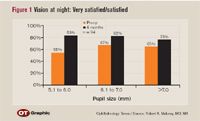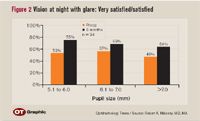Article
Wavefront-guided LASIK safe, accurate in high myopia, study reveals
LASIK using certain wavefront technology (CustomVue, Advanced Medical Optics) continues to provide accurate, safe correction of high myopia according to the results of the VISX Investigational Study Group for Higher Myopia with the U.S. Clinical Trials.

Key Points

The investigators found that there was a significant improvement in the patients' night vision, and large pupils are not a contraindication to this treatment, as reported by Robert K. Maloney, MD, MA. He is director, Maloney Vision Institute, and clinical professor of ophthalmology, University of California, Los Angeles.
In this clinical trial that included 94 patients, all eyes were targeted for emmetropia, and an 8-mm blend zone with a 6-mm optical zone was used. However, this prompted the investigator to ask whether the zone was sufficiently large to provide patients with optimal vision.
"This was an extremely challenging group of patients to satisfy," he said.
Are there aberrations?

When the investigators considered higher-order aberrations, almost no eyes had worsening of trefoil and spherical aberration greater than 0.1 D. Interestingly, 47% had an increase in coma that exceeded 0.1 D.
"This finding is striking, because one would expect the spherical aberration to increase in patients who have high myopia," Dr. Maloney said. "This tells us that the cornea really is prolate within the ablation zone, and the peripheral knee has been pushed outside of the optical zone, where it is not causing spherical aberration."
Coma increased in these eyes because no eyes were treated with iris registration, he said.
"My personal suspicion is that this represents micro decentrations of the ablation zone," Dr. Maloney said. "Wavefronts are done with photopic pupils, whereas ablations are done with small pupils. The position of the pupil shifts slightly from dilation to constriction," he said. The iris registration software in the proprietary wavefront system addresses this problem.
Iris registration software should be used when treating highly myopic patients, Dr. Maloney said, even though the ablations already are wavefront-guided.
The patients were asked before and after LASIK about the frequency with which they experienced halos around lights at night.
"Before surgery, the patients were wearing glasses, and after surgery they wore no correction. There was very little change from preoperatively to postoperatively in the frequency of halos," Dr. Maloney reported.
The exception was that, preoperatively, 2% of patients always had halos, but postoperatively, 8% reported that they always had halos.
"There was a small increase in the perception of halos in this population," he said. Patients should be warned about this possibility, he said.
Newsletter
Don’t miss out—get Ophthalmology Times updates on the latest clinical advancements and expert interviews, straight to your inbox.




